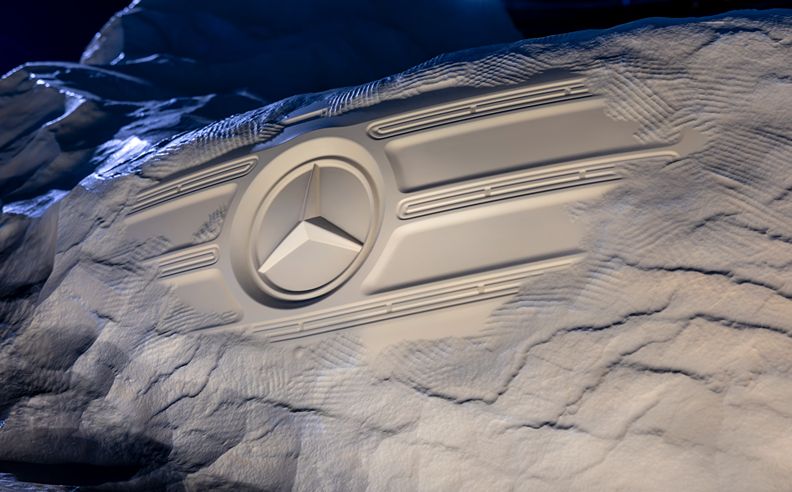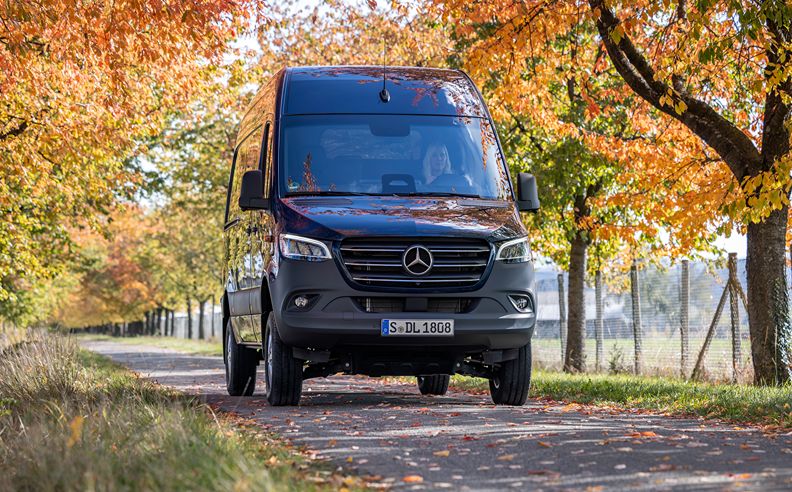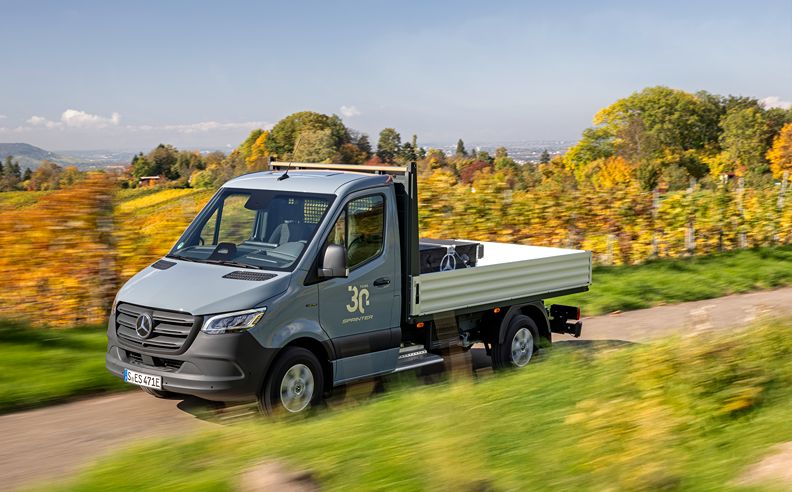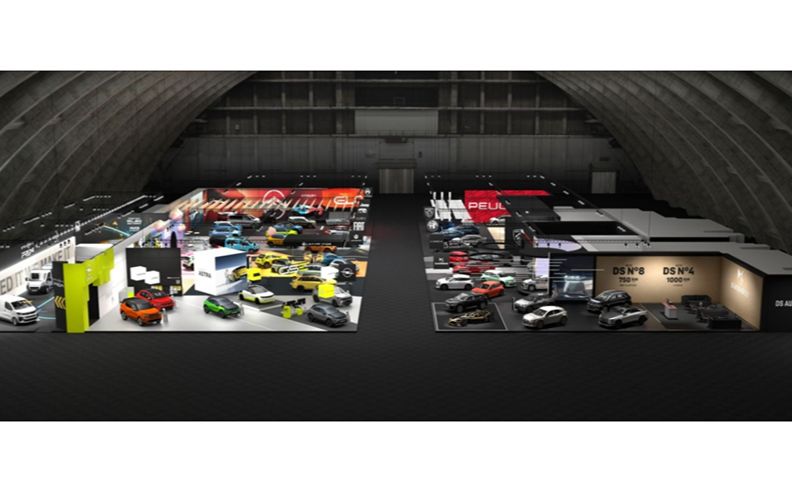
In the run-up to its “130 Years of Transportation” anniversary, Mercedes Benz Vans is drawing an exciting parallel from the past to the future: with the presentation of the world’s oldest roadworthy delivery van, a Benz combinations delivery vehicle, and a current eSprinter, the inventor of the van looks back on its unique success story that started in 1896. It’s a history full of customer-specific transport solutions. Mercedes Benz vans have always been intended as rock-solid dependable business tools. And this will remain the case in future. The company emphasises this with the unveiling of “THE BOuLDER” – an impressive and expressive stone-look sculpture. It offers a first glimpse of how Mercedes Benz is reinventing the van once again while retaining its core values – robustness, reliability, versatility and durability. The 650 centimetre-long, 275 centimetre-high and 250 centimetre-wide sculpture combines art and craftsmanship in a fascinating way and offers a preview of the next generation of the Sprinter. Milled from a solid piece of material, the first outlines and design details of the future Sprinter begin to emerge. They give an idea of the upcoming unique exterior design, which is geared towards the diverse needs and requirements of commercial customers. Furthermore, the sculpture conveys an impression of the dimensions of the future Mercedes Benz van.

“As the inventor of the light commercial vehicle, we’ve been consistently putting all our expertise and experience at the service of our commercial customers for almost 130 years. Their benefits and added value are our top priority – then, now and in the future. Customer satisfaction and innovative solutions are deeply rooted in our corporate DNA and form the foundation of our premium vans.”
Thomas Klein, Head of Mercedes-Benz Vans
“The next generation of Mercedes-Benz vans will focus on innovative powertrains, connectivity and advanced digital services. Functionality and customer needs are at the heart of our development. We’ve tailored our Mercedes-Benz Operating System specifically to commercial use and with it, will redefine the van segment once again. We offer our customers state-of-the-art technology combined with efficiency and tailor-made intelligence. I’m confident that our future Sprinter will be the flagship in its segment more than ever before.”
Andreas Zygan, Head of Development at Mercedes-Benz Vans
Benz combinations delivery vehicle from 1899 – the oldest roadworthy Mercedes Benz transporter. The success story of Mercedes Benz Vans began under the name Benz & Cie. in 1896, when Carl Benz invented the motorised transporter. He developed two models to meet different customer needs: the Benz delivery van as a “carriage with an enclosed body” based on the Benz Victoria, and the Benz combinations delivery van as a “small coachman’s carriage with a removable body” based on the smaller and lighter Benz Velociped. Thanks to its removable body, it could be converted into a two-seater passenger car in just a few simple steps, making it particularly versatile. It was, in effect, the first multi-purpose vehicle.

Both models were powered by a rear-mounted single-cylinder four-stroke engine with a displacement of 2.7 litres in the delivery van and 1.0 litres in the combination delivery vehicle. A payload of 300 kilograms (plus driver) was sufficient for inner-city transport. The power output of 2.75 to 6 hp was sufficient for a top speed of 15 to 20 km/h when fully loaded. The new vehicles were thus faster than a two-horse carriage and could also carry around three times as much payload. A new market segment in the still-young history of the automobile was born, and Carl Benz had once again proven himself to be a visionary inventor. The Mannheim-based company handed over the first example of the delivery van to the Du Bon Marché department store in Paris on December 5, 1896, at a sales price of 4,500 marks.
Today, the oldest roadworthy transporter is a Benz combination delivery vehicle from 1899 in the Mercedes Benz Classic collection. It was meticulously restored (frame) and rebuilt (body) for next year’s ”130 years anniversary. It is a model that was built under licence in England by Hewetson’s Ltd., the official Benz representative in UK. Known as the Ideal Van, it had an output of 3 hp and could carry a payload of around 100 kilograms plus the driver. Later models had 3.5 hp and could transport up to 250 kilograms.
30 years of the Mercedes-Benz Sprinter – the tailor-made all-rounder that keeps the world moving. Around 100 years after the invention of the transporter, Mercedes Benz Vans revolutionised the light commercial vehicle segment once again in 1995 with the Sprinter. Therefore, Mercedes Benz closed the gap between cars and trucks and gave its name to an entire vehicle class. To this day, it is valued for its exceptional versatility and reliability, its high level of comfort and car-like driving characteristics. Over five million Sprinters have been produced in three decades in different variants for different purposes and for almost all situations in life: As the ideal van it is there when lives are saved and children are born, when parcels or frozen food are delivered, when houses are built and bathrooms are renovated, when VIPs are driven or travel adventures are experienced. This makes the Sprinter a reliable partner for a wide range of industries worldwide. In 2024, 77 percent of customers in Europe chose a Sprinter again. This high repurchase rate proves how popular this industry icon is.

The Sprinter of the future – even more versatile, efficient, and intelligent. The introduction of the new VAN architecture marks the beginning of a new era with even more efficient, intelligent, and versatile vans. The next generation of vans will not only continue the Sprinter’s success story but also define the van class of the future.
The new vehicle architecture will form the basis of all newly developed medium-sized and large Mercedes Benz vans in the future. It allows for a clear differentiation between privately positioned large-capacity grand limousines (VLE and VLS) and commercially positioned vans in the premium segment. Beginning in 2026, the fully electric models of the Van Electric Architecture (VAN.EA) will be introduced for private customers. The VLE will be the first model to be launched. Electric commercial transporters will follow up later. With the second version of the VAN architecture, the Van Combustion Architecture (VAN.CA), state-of-the-art combustion engine vans will also complement the future portfolio for private and commercial use.
The commercially positioned vans were developed in close collaboration with customers from various industries and are therefore consistently tailored to their needs and requirements. This is partly due to the new design, which the sculpture already hints at. In addition, the future Sprinter will be available with a variety of drive systems and in numerous length, wheelbase and weight variants. It is therefore made to measure for different configurations and industry-specific body and conversion solutions – from courier, express and parcel services to refrigerated vehicles, service and workshop vehicles, ambulances and rescue vehicles, flatbed vehicles for construction sites and passenger transport for people with limited mobility, right through to camper vans. The aim is to meet all customer requirements in the best viable way and to further expand the leading position in the van market.
More digital than ever before: over-the-air updates keep vehicle functions up to date for years to come. The next generation of vans will also set new standards in terms of connectivity and software. They will run entirely on the company’s own Mercedes Benz Operating System (MB.OS). This makes them the most intelligent Mercedes Benz vans ever. The deep integration of chip-to-cloud architecture into the vehicle allows all actuators and sensors to be precisely controlled – from infotainment and comfort features to charging – for an unparalleled driving experience as well as the intelligent integration of vehicle functions into the user interface. This comprehensive deep integration creates new opportunities for customers who benefit from even greater connectivity in their vehicles. Digital Extras tailored to customer needs, such as Mercedes Benz Van Uptime Monitor or Large Vehicle Navigation, make the maintenance and use of their own vans even more efficient.
Thanks to AI-supported MB.OS, every van will be equipped with high-performance computers that are connected to the Mercedes Benz Intelligent Cloud. This enables over-the-air updates of the entire vehicle software, including driver assistance systems. Every van remains up to date for years to come – quite similar to a smartphone, which can be regularly equipped with new apps and extended functions. MB.OS offers maximum flexibility for seamlessly integrating content from external providers. This allows commercial customers to use their own applications and necessary tools, for example for fleet management or navigation, directly in the vehicle on the head unit. The typical Mercedes Benz user interface remains unchanged – for the familiar and valued customer experience.

Motor 283 is the biggest automotive website created by a team of automotive enthusiats and this author page is used to show the readers the press releases and news posted on Motor 283 website.

